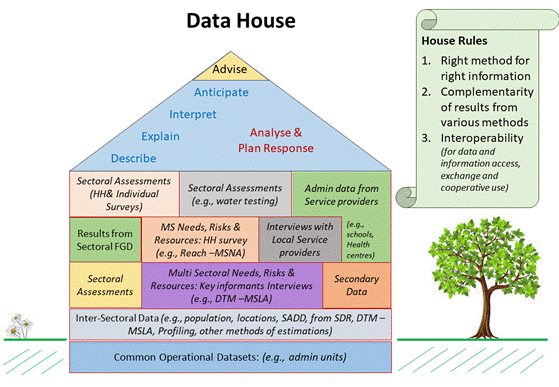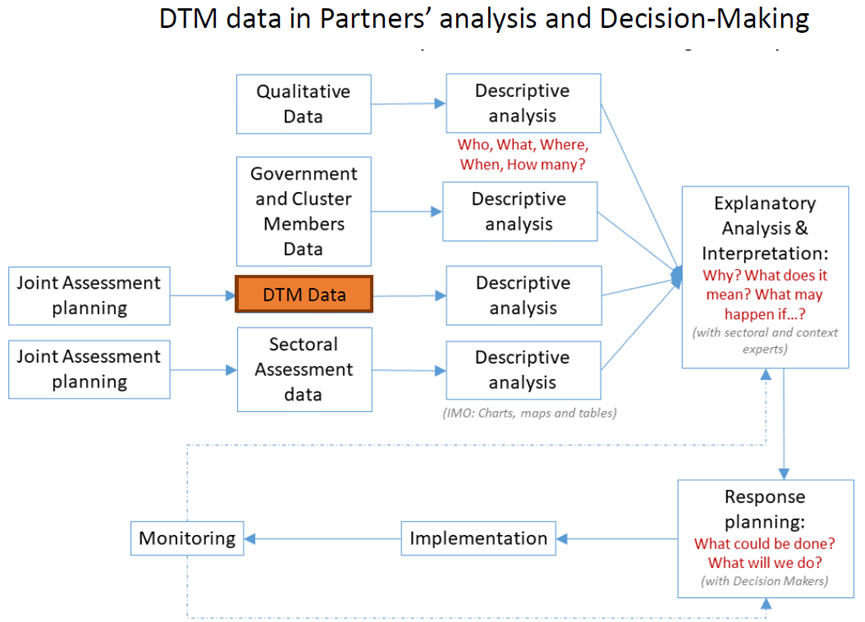DTM and other data collection systems can be used to complement each other.

DTM and Partners can shift the approach from competition to complementarity using their datasets and systems to:
- provide different types of needed information to decision-makers
- help verify each other’s results
- fill each other’s gaps
- remedy to each other’s (necessary) limitations
Differences in datasets can be used to gain a better understanding of the issues, when a genuine professional and scientific approach is used and presumption around own data is let go by all sides.
Strengths and Limitations of DTM MSLA
- DTM and Partners should both be clear that all methodologies, including DTM Multi-Sectoral Location assessment, have strengths and limitations: DTM MSLA is not a Sectoral Needs Assessment tool. It does not interview individuals or HH, and DTM enumerators and key informants are not sectoral experts. DTM questions should be designed to be answered by non-sectoral experts, in a way that results can be used by sectoral experts for analysis.
- DTM usually has a large and consistent coverage of the crisis, can be adjusted to collect information that clusters, and other partners need, and provides regular updates on critical issues. In addition, its data are collected over time, and can be analysed to indicate how displacement and conditions of displaced populations evolve over time.
Partners develop their response planning after analysing information from DTM MSLA together with available information from other sources (e.g., HH surveys, Facility-level data, Focus Group discussion results, technical assessments…)

Available Tools
- Handout Methods and Information, in: https://dtm.iom.int/dtm-partners-toolkit/other-tools-0. It helps DTM and Partners reach a shared understanding of how data collected at different level of measurement/analysis provide different information, and how each method of data collection should be used for a specific level of measurement/analysis.
- Frequently Asked Questions on DTM for clusters (In English, French and Spanish), in: https://dtm.iom.int/dtm-partners-toolkit/what-dtm. It is a short (2-pager) introducing DTM components/methodologies and highlighting strengths and limitations of DTM MSLA
- Presentations on DTM (In English, French and Spanish), in: https://dtm.iom.int/dtm-partners-toolkit/presentations-dtmen-fr-and-sp. Presentations can be used to introduce DTM components/methodologies and highlighting strengths and limitations of DTM MSLA.
- Methodological Framework used in DTM Operations for Quantifying Displacement and Mobility, in: https://dtm.iom.int/about/methodological-framework. It details the various DTM methodologies (technical document).
- DTM data in Clusters and WGs analysis and decision making, in: https://dtm.iom.int/dtm-partners-toolkit/analysis
- Addressing differences in population data, practical approaches to different population data, in: https://dtm.iom.int/dtm-partners-toolkit/population-data. This 2-pager provides practical approaches developed and used by DTM and UNHCR when population datasets do not match. It helps guide the cooperation to identify reasons for different numbers, and opportunities for better understanding of population data.
